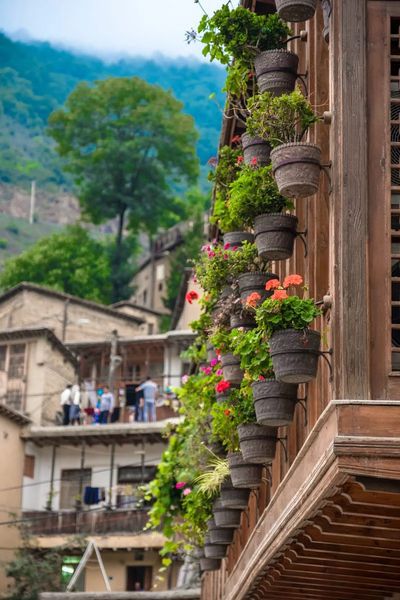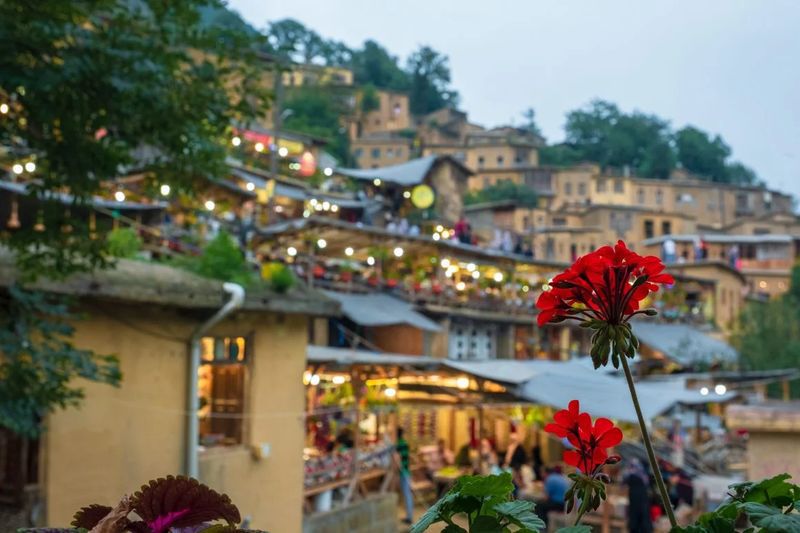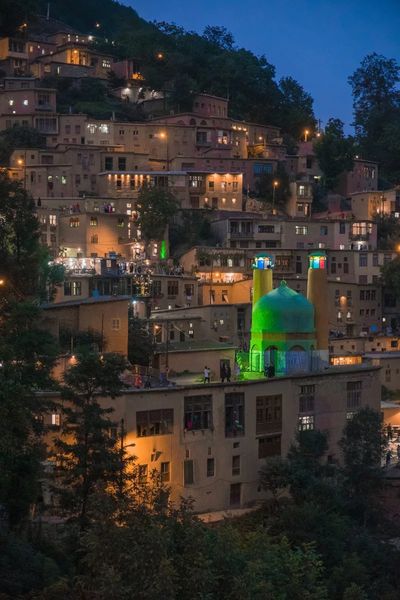
Perched on the slopes of Mt. Alborz in the northern Gilan region of Iran, Masuleh Village stands as a captivating testament to the area’s rich history and architectural brilliance.
Dating back to 1006 AD, this extraordinary settlement showcases a unique structure molded by the contours of its surroundings. Masuleh Village’s rooftops not only offer protection from the elements but also form an intricate network of streets. Beyond its architectural wonders, Masuleh provides strategic solutions to Iran’s climatic adversities, particularly its cold winters, by maximizing solar exposure and higher temperatures.
In this post, we will delve into the captivating history, architectural intricacies, and daily rhythms of life in Masuleh Village, offering a glimpse into its enduring charm.
Historical Significance and Origins
The historical significance and origins of Masuleh Village are deeply rooted in the annals of Iran’s past. Established in 1006 AD, Masuleh carries a rich heritage shaped by centuries of cultural exchange and local ingenuity.
Originally founded as a small settlement, Masuleh’s strategic location along ancient trade routes contributed to its growth and development. Over time, it evolved into a thriving community, characterized by its unique architectural style and strategic layout.
The origins of Masuleh’s distinctive architecture can be traced to both practical and cultural factors. Situated on steep mountain slopes, the village’s terraced layout reflects a harmonious adaptation to the surrounding topography, maximizing space utilization while providing stability against natural elements such as landslides.
Moreover, Masuleh’s architectural design serves as a testament to the region’s cultural heritage, incorporating elements of Persian and local Gilaki traditions. The village’s interconnected rooftops, narrow alleys, and vibrant colors evoke a sense of intimacy and community, fostering social cohesion among its inhabitants.
Throughout its history, Masuleh has witnessed periods of prosperity and decline, shaped by factors such as economic fluctuations, political upheavals, and environmental changes. Despite these challenges, the village has endured, preserving its cultural identity and architectural legacy for future generations to cherish.
Today, Masuleh stands as a living testament to Iran’s rich history and cultural diversity, attracting visitors from around the world who come to marvel at its timeless beauty and explore its fascinating heritage.

Architectural Marvels
Masuleh Village stands as an architectural marvel, blending seamlessly with the natural landscape of the Alborz Mountains. Its unique construction and layout have earned it recognition as a UNESCO World Heritage Site and continue to captivate visitors from around the globe.
One of the most striking features of Masuleh’s architecture is its terraced layout. Buildings are constructed on steep slopes in a step-like manner, with each rooftop serving as the pathway for the buildings above. This distinctive design not only optimizes land use but also ensures stability against the region’s frequent landslides.
The buildings themselves are made of locally sourced materials, including clay, wood, and stone, reflecting the village’s sustainable approach to construction. Intricately carved wooden doors and colorful stained glass windows adorn the facades, adding to the village’s charm and character.
Another remarkable aspect of Masuleh’s architecture is its interconnected rooftops, which form a labyrinthine network of streets and alleyways. Visitors can wander through the village’s narrow passageways, lined with vibrant flowers and bustling with activity, immersing themselves in its rich cultural tapestry.
Despite its ancient origins, Masuleh has adapted to modern times while preserving its architectural heritage. Today, many of the village’s historic buildings have been repurposed as guesthouses, cafes, and shops, providing visitors with an authentic glimpse into daily life in this enchanting mountain retreat.
Overall, Masuleh’s architectural marvels serve as a testament to human ingenuity and resilience, showcasing the enduring beauty of Iran’s cultural heritage.

Daily Life in Masuleh
Daily life in Masuleh Village is a vibrant tapestry woven with traditions, community bonds, and a deep connection to the natural surroundings. Residents of Masuleh, known as Masulehsari, lead lives deeply intertwined with the rhythms of the mountains and the seasons.
Each day begins with the soft glow of dawn cascading over the terraced rooftops, signaling the start of a new day. Families emerge from their cozy homes, greeting neighbors with warmth and hospitality. The scent of freshly brewed tea wafts through the air as villagers gather in the local teahouses to share stories, laughter, and news of the day.
Masuleh’s narrow alleys and winding streets come alive with activity as residents go about their daily routines. Women in colorful traditional dress carry out household chores, while men tend to the fields or engage in artisanal crafts such as woodworking or carpet weaving.
Throughout the day, the sounds of children playing echo through the village, their laughter mingling with the chirping of birds and the rustle of leaves. Masuleh’s natural beauty provides the perfect backdrop for outdoor activities, and residents often take advantage of the surrounding mountains for hiking, picnicking, and leisurely strolls.
As evening falls, the village settles into a tranquil rhythm. Families gather for hearty meals of local cuisine, sharing stories and traditions passed down through generations. The night sky sparkles with stars, casting a magical glow over Masuleh’s terraced rooftops.
In Masuleh, time seems to slow down, allowing residents and visitors alike to savor each moment and appreciate the simple joys of life. It is a place where tradition meets modernity, where the past and present coexist in perfect harmony, creating a truly timeless and unforgettable experience.

Masuleh Village Summary
Masuleh Village, nestled on the slopes of Mt. Alborz in Iran’s Gilan region, is a captivating testament to history, culture, and architectural ingenuity. Dating back to 1006 AD, this unique settlement boasts a terraced layout that maximizes space and stability against natural elements. Its interconnected rooftops form a labyrinthine network of streets, reflecting a harmonious blend of Persian and Gilaki traditions.
Masuleh’s architecture, constructed from locally sourced materials, features intricately carved wooden doors and colorful stained glass windows, adding to its charm. Despite its ancient origins, Masuleh has adapted to modern times while preserving its cultural heritage, with many historic buildings repurposed as guesthouses and shops.
Daily life in Masuleh revolves around community bonds, traditions, and a deep connection to nature. Residents, known as Masulehsari, gather in teahouses to share stories, while children play amidst the village’s narrow alleys and winding streets. Evenings are spent enjoying hearty meals and the tranquility of the mountain setting.
Overall, Masuleh Village stands as a timeless gem, offering visitors a glimpse into Iran’s rich history and cultural diversity, as well as a tranquil retreat amidst stunning natural beauty.
generic chloroquine plaquenil over the counter
Great article. I’m experiencing some of these issues as well..0mniartist asmr
Wow, great blog article.Thanks Again. Really Great.
I loved your blog article. Will read on…
Very good post.Really thank you! Will read on…
As long as the live score app delivers that selection, yes youcan.
wow, awesome article.Thanks Again. Great.
Thanks-a-mundo for the article post.Really thank you! Keep writing.
A big thank you for your post.Really thank you! Cool.
A big thank you for your post.Really looking forward to read more. Cool.
Really informative post.Really thank you! Really Great.
Awesome post.Really looking forward to read more. Awesome.
I don’t even know how I ended up here, but I thought this post was great. I don’t know who you are but certainly you’re going to a famous blogger if you aren’t already Cheers!
top topan mp3 says:Thanks for the blog article.Reply 11/01/2021 at 6:20 pm
A big thank you for your article post.Thanks Again. Cool.
This is one awesome article post.Really looking forward to read more. Great.
Im obliged for the article. Fantastic.
I cannot thank you enough for the article post.Really looking forward to read more. Really Great.
Massage the others, please.” I protested. But what are you going to do? Later, Aden’s sister will sit with you again.” “Ah, it’s okay, sis.
wow, awesome blog. Much obliged.
I cannot thank you enough for the article post.Much thanks again.
Appreciate you sharing, great blog post. Cool.
Really informative blog post.Much thanks again. Really Great.
Really informative blog.Much thanks again. Awesome.
Thanks for the blog post.Really thank you! Fantastic.
Asking questions are genuinely pleasant thing if you are not understanding anything totally, butthis piece of writing offers nice understanding yet.
Thanks-a-mundo for the blog post.Thanks Again. Keep writing.
Fantastic blog post.Thanks Again. Really Great.
A round of applause for your article. Fantastic.
Muchos Gracias for your blog post. Fantastic.
Wow, great blog post.Really thank you! Will read on…
Very good article post.Thanks Again. Really Great.
Fantastic article.Really looking forward to read more. Awesome.
Great post. I was checking continuously this blog and I’m impressed! Extremely useful info particularly the last part 🙂 I care for such information a lot. I was seeking this certain info for a very long time. Thank you and good luck.
I really enjoy the post.Really looking forward to read more. Will read on…
I really like and appreciate your blog article.
I truly appreciate this blog post.Really looking forward to read more. Great.
Looking forward to reading more. Great post. Great.
I cannot thank you enough for the blog post.Really thank you! Will read on…
Awesome blog. Great.
I think this is a real great article post.Much thanks again. Great.
I value the blog.Really thank you! Really Great.
Great article post. Cool.
Awesome post.Really looking forward to read more.
This is one awesome post.Thanks Again. Much obliged.
Thanks a lot for the blog post. Really Great.
I appreciate you sharing this blog post.Really looking forward to read more. Really Great.
A big thank you for your blog article.Thanks Again.
I really enjoy the blog. Really Cool.
Im thankful for the article post.Much thanks again. Great.
Thanks for sharing, this is a fantastic article.Really looking forward to read more. Great.
Very good post.Really looking forward to read more. Really Great.
I really like and appreciate your post.Much thanks again.
Thanks for sharing, this is a fantastic blog article.Really looking forward to read more.
You made some good points there. I did a search on the issue and found a good number of persons will go along with with your blog.
This is one awesome article.Really looking forward to read more. Awesome.
Enjoyed every bit of your blog article. Really Cool.
Thanks-a-mundo for the post. Keep writing.
apartment plants rentberry scam ico 30m$ raised parkmerced apartments
Major thankies for the blog article.Much thanks again. Keep writing.
Thanks so much for the article post.Really thank you! Will read on…
Enjoyed every bit of your article post.Really looking forward to read more.
This is one awesome post.Really thank you! Much obliged.
Thanks for the article post.Much thanks again. Great.
I think this is a real great article.Really looking forward to read more. Want more.
Thank you for your blog post.Really looking forward to read more. Much obliged.
Fantastic article post.Thanks Again. Really Great.
Major thankies for the blog.Really looking forward to read more. Want more.
I value the blog.Really looking forward to read more.
Great article post.Really thank you! Great.
This is one awesome article.Really looking forward to read more.
I loved your article post.Much thanks again. Really Great.
You made your point.essay writing review dissertation writing medical personal statement writing service
Im grateful for the blog article.Much thanks again. Great.
Very good article post.Thanks Again. Really Cool.
Thanks-a-mundo for the blog article.Much thanks again. Great.
I cannot thank you enough for the post.Much thanks again. Want more.
Im thankful for the post.Really looking forward to read more. Keep writing.
Muchos Gracias for your article post.Really looking forward to read more. Awesome.
Major thanks for the blog post.Really thank you! Will read on…
Really enjoyed this blog.Thanks Again. Really Great.
Great blog.Thanks Again.
Thanks a lot for the blog.Really looking forward to read more. Really Great.
Very good article. Awesome.
Appreciate you sharing, great blog. Keep writing.
I really like and appreciate your blog post.Really thank you! Really Cool.
Looking forward to reading more. Great post.Really looking forward to read more. Want more.
This is one awesome post.
A round of applause for your blog post.Really looking forward to read more. Much obliged.
I really enjoy the blog. Awesome.
I really like and appreciate your article post.Thanks Again. Cool.
Great article.Really looking forward to read more. Great.
Thanks again for the post.Thanks Again. Keep writing.
Thanks so much for the post.Really thank you! Cool.
Thanks a lot for the post.Really thank you! Really Great.
Thank you ever so for you article.Really looking forward to read more. Will read on…
Really informative blog post. Cool.
I value the blog.Much thanks again. Cool.
Im grateful for the blog post.Thanks Again. Really Great.
Really appreciate you sharing this article.Much thanks again. Want more.
Really appreciate you sharing this article post.Much thanks again. Cool.
Major thankies for the article.Much thanks again. Fantastic.
Thanks a lot for the blog post.Really looking forward to read more. Keep writing.
Im thankful for the blog article. Much obliged.
Im obliged for the blog post.Really looking forward to read more. Will read on…
I truly appreciate this article post.Really thank you!
A big thank you for your article.Really thank you! Awesome.
A round of applause for your article post.Really looking forward to read more. Much obliged.
I appreciate you sharing this blog article.Much thanks again. Great.
Major thankies for the article.Much thanks again. Keep writing.
Great, thanks for sharing this article post.Really looking forward to read more. Want more.
wow, awesome article.Thanks Again. Want more.
Really enjoyed this blog.Much thanks again. Really Cool.